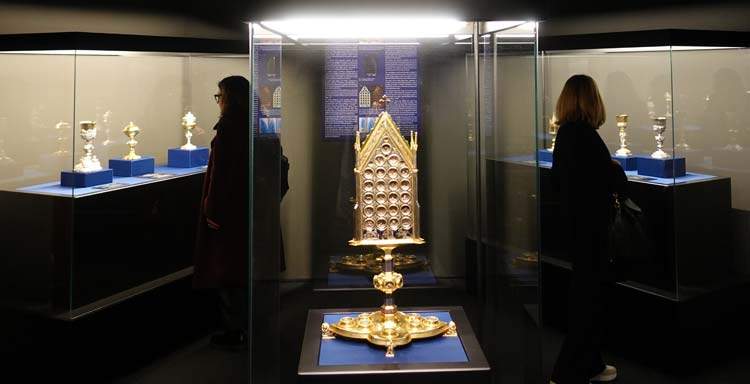More than 30 years after its theft, the Reliquary of St. Galgano returns to public view: On the night of July 10-11, 1989, a major theft at the Diocesan Museum of the Archdiocese of Siena - Colle di Val d’Elsa - Montalcino, at the time set up in the premises adjacent to the Pontifical Regional Seminary "Pio XII," in the locality of Montarioso, in the Municipality of Monteriggioni, made several precious objects of medieval and Baroque goldsmithing disappear from the museum, including the famous Reliquary of St. Galgano, from the ancient Abbey and formerly kept in the Parish of Frosini in the Municipality of Chiusdino. Besides the historical and artistic value of the sacred objects, it was a painful wound for the Sienese Church, which was being mutilated and disfigured in its spiritual memory.
In addition to the Reliquary of Saint Galgano, a precious early 14th-century object in gilded copper and enamels, attributed to the school of Sienese goldsmiths Tondino di Guerrino and Andrea Riguardi (it is one of the most precious artifacts of this era, particularly for the refinement and sophistication of the translucent enamels depicting episodes from the life of Saint Galgano), a 12th-century astylar cross (the oldest piece in the loot: presents an interesting Romanesque iconography of Christus vivens on the cross, his feet resting on the head of a serpent, in reference to the biblical passage in Genesis 3:15: “I will put enmity between you and the woman, between your seed and her seed: she shall crush thy head, and thou shalt bruise her heel.”), a 14th-century copper tempietto reliquary, a 14th-century gilded copper chalice, a 17th-century silver pyx, and six other chalices, two from the 17th century and four from the 18th century, all made of silver.
The discovery occurred last year, when the Carabinieri’s Cultural Heritage Protection Unit returned ten of the eleven pieces stolen from the Diocesan Museum to the custody of the Archdiocese after finding them on the antiques market. The only piece not found was a 17th-century silver chalice from the Certosa di Maggiano church in Siena. The works then went to the Vatican Museums’ Laboratories for restoration. And now it all comes back on view in the exhibition From the Sword to the Cross. The restored reliquary of St. Galgano. The exhibition, produced thanks to the collaboration between the Vatican Museums, the Archdiocese of Siena-Colle di Val d’Elsa-Montalcino and the Opera della Metropolitana di Siena, with contributions from Opera Laboratories, Sillabe and Giovanni Raspini, will be held in Room XVII of the Vatican Museums’ Pinacoteca, from Dec. 7, 2022 to Feb. 18, 2023.
According to tradition, Galgano is said to have been born in the Sienese village of Chiusdino. A knight belonging to the local petty nobility, he converted to the ascetic and hermitic life after visions of the Archangel Michael, as depicted in the six scenes of the Reliquary. He led his monastic life in the Hermitage of Montesiepi, which he built on a hill near the place where the Abbey would rise. He died, according to sources, on November 30, 1181. Just four years later a commission of inquiry was convened, which led Pope Lucius III to proclaim him a saint in 1185.
Attributed to Galgano in his iconographic representation is the famous sign of the sword driven into the rock that becomes a cross before which to kneel and pray. However, his fame is established against the backdrop of the diatribe between the Papacy and the Empire over “investitures” and in the context of the expansion of the Cistercian Order thanks to the work of St. Bernard of Clairvaux.
T he work conducted by the Vatican Museums’ Metal and Ceramic Restoration Laboratory on the goldsmiths on display in the exhibition involved a campaign of scientific investigations that supported the methodological choices of the intervention. The protagonist of the conservation work was the Reliquary of St. Galgano, which was entirely disassembled in the presence of the referent of the Archdiocese of Siena, with the simultaneous securing of the seventy-four relics present.
Numerous damages were sustained as a result of the theft. Among these, the most obvious were the fracture of the shaft from the foot, deformations of the spires, and the loss of the first hexagonal enamel spool joining the foot, reconstructed by scanning from an archival image. Other small missing elements were made of resin with a 3D printer. The recto and verso faces , decorated with enamels, were cleaned and consolidated and finally treated with plasma. The apex cross, also lost, was reproduced by master goldsmith Giovanni Raspini based on models of coeval works.
The display, designed and created by Opera Laboratori and Sillabe, was also conceived from the outset for display in Siena, where theexhibition will move, in the evocative premises of the so-called Crypt of the Cathedral, from March 1 until November 5, 2023, so as to return to the Sienese community and to the Cathedral’s many visitors a significant testimony to the city’s cultural, artistic and spiritual identity.
 |
| More than 30 years after theft, the Reliquary of St. Galgano returns to view |
Warning: the translation into English of the original Italian article was created using automatic tools. We undertake to review all articles, but we do not guarantee the total absence of inaccuracies in the translation due to the program. You can find the original by clicking on the ITA button. If you find any mistake,please contact us.